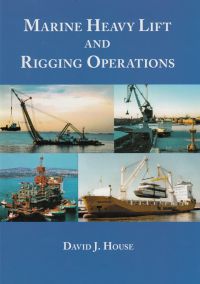Marine Heavy Lift & Rigging Operation 2nd Edition 2019 By David J. House
₱11,500.00
ISBN:978-0-85174-720-0
Published date:First edition 2005
1 in stock
This new publication covers the topic of Heavy Lifts within the marine industry. It is profusely illustrated and is directly aimed at the many industry sectors including: salvage operations, the offshore section, with the ship building and repair sectors, as well as the cargo aspects of the maritime environment.
The movement of bulk cargoes, both dry and liquid has expanded considerably alongside increased development in the third world. However, this expansion has not been limited to just bulk cargoes. Containerisation, roll on, roll off and designated project cargoes are all sectors which have seen increased activity in the field of heavy lifting practice.The lifting and transportation of heavy weights has always been inherent with the maritime industries. The purpose of this work is designed to show not only some of the many routine lift operations aboard ships, but also the specialist movements of excessive loads, in a highly competitive commercial market.
The Offshore Industry in particular, generated probably the greatest interest in modular construction for oil and gas installations around the world. It is from the origins of the early floating cranes, which later developed the multi-purpose crane barges, floating sheer legs and salvage craft that has led to the massive activity and development in our coastline regions. Installations being constructed to mammoth proportions dominate the skylines of the world.
The rigging skills of personnel associated with a successful lift operation, should not be undermined. Their dedication to achieving what sometimes may appear as the impossible lift, is without equal. By the very nature of the task, the managers and operators have placed the safety of personnel and the protection of the environment at the forefront of the heavy-lift/transport industry. Nothing can expect to move without detailed ‘Risk Assessment’ and even then Project cargoes, heavy lift ships and major commercial operations all adhere to the first maritime principal for the Safety of Life at Sea.
Chapter 1 – Shipboard Heavy Lifting Gear
Heavy Lifting Derricks, Cranes and Associated Equipment-Afloat. Parts of Derrick/Crane Structures. Conventional Jumbo Derricks-Velle, Stuelcken. Surveys. Shipboard Gantry (container) Cranes-Lifting Cradles & Controlling Heavy Loads. Plant Test & Maintenance.
Chapter 2 – Heavy Lifting Practice
General Cargo H/L Operations. Safety Procedures-Stability and Operation. Loading and Discharging Heavy Lifts to and from Conventional Vessels. Risk Assessment. Securing the Load. Ground Handling Equipment. Container Loads. Stability Examples.
Chapter 3 – Heavy Cargoes
Heavy “Ro-Ro” Cargoes and Securing. Tanker Vessel Lifting Operations. FSOP & SBM Operations-Anchor Handling. Heavy Cargo Transports, e.g. Bulk Ore, Steel (coils), Scrap Metal. Dangers and Precautions. Shoreside Container Terminal Gantries and Heavy Cranes. Heavy Container Handling.
Chapter 4 – Shipyard Heavy Lifting
Jumboisation-Lifting Operations, Synchro Lift Operations. Hydro-lift, Floating Docks. Slipways.
Chapter 5 – Heavy Lifts, Floating Cranes And Salvage Rig Operations.
Sheer Legs-Associated Equipment and Salvage Preparations. Winches and Capacities. Operational examples: “Herald of Free Enterprise” and “Empress Canada.”
Chapter 6 – Specialisation in Marine Heavy Lifts and Project Cargoes
Tug Use. Towing, Handling and the Positioning of Heavy Structures. Water borne H/L Projects, e.g. Wind Farms, Jack-ups. Heavy Lift Vessels’ Specialisation Operations. Helicopter Lifting Operations. Dangers and Precautions. Military Lifting Requirements. Voyage Planning.
Also included:- Introduction to Marine Heavy Lift and Rigging Operations; Abbreviations List; Conversion Tables; Heavy Lift Terms and Phraseology; Main Maritime Heavy Lift Operators; Information on Inherent Shipboard Lifts; Merchant Shipping Notices. Questions & Answers-Self Examination.
Be the first to review “Marine Heavy Lift & Rigging Operation 2nd Edition 2019 By David J. House” Cancel reply
Related products
Brown, Son & Ferguson
Astronomy Simply Explained for Beginners By F.W. Murray First published 1912-7th edition 1985
Brown, Son & Ferguson
Cordage and Cables By Captain P.J. Stopford First published 1925-2nd edition reprinted 1987
Brown, Son & Ferguson
Browns Knots and Splices By Capt S. Jutsum First published 1912-3rd edition 1983
Brown, Son & Ferguson
Coastal and Deep Sea for Yatchsmen by C.A LUND 6Ed. Reprinted 1972
Brown, Son & Ferguson
Dictionary of Nautical Words and Terms, by A.G.W Miller 4th Ed. 1994 reprinted 2002












Reviews
There are no reviews yet.